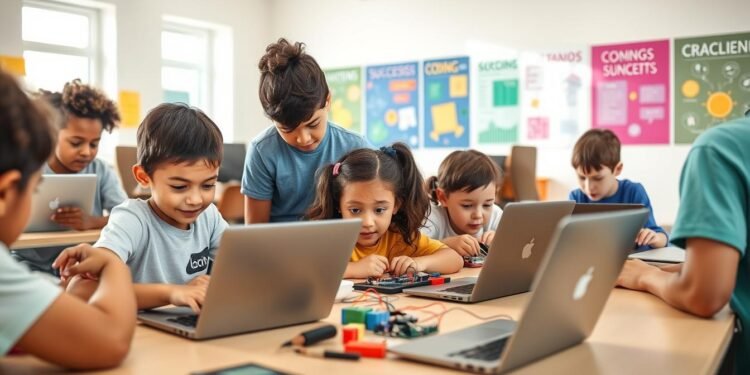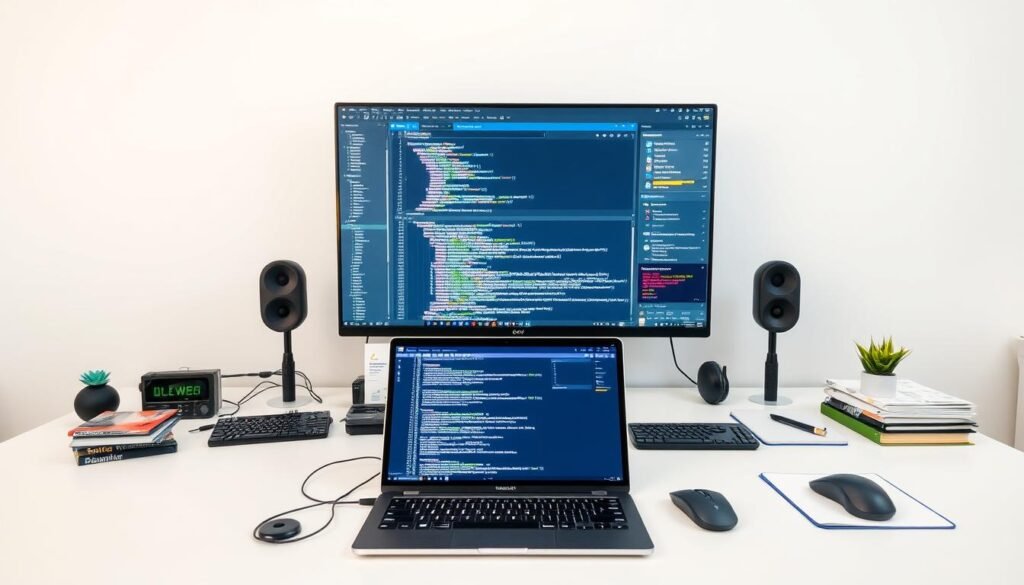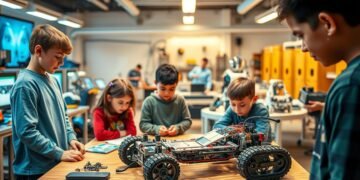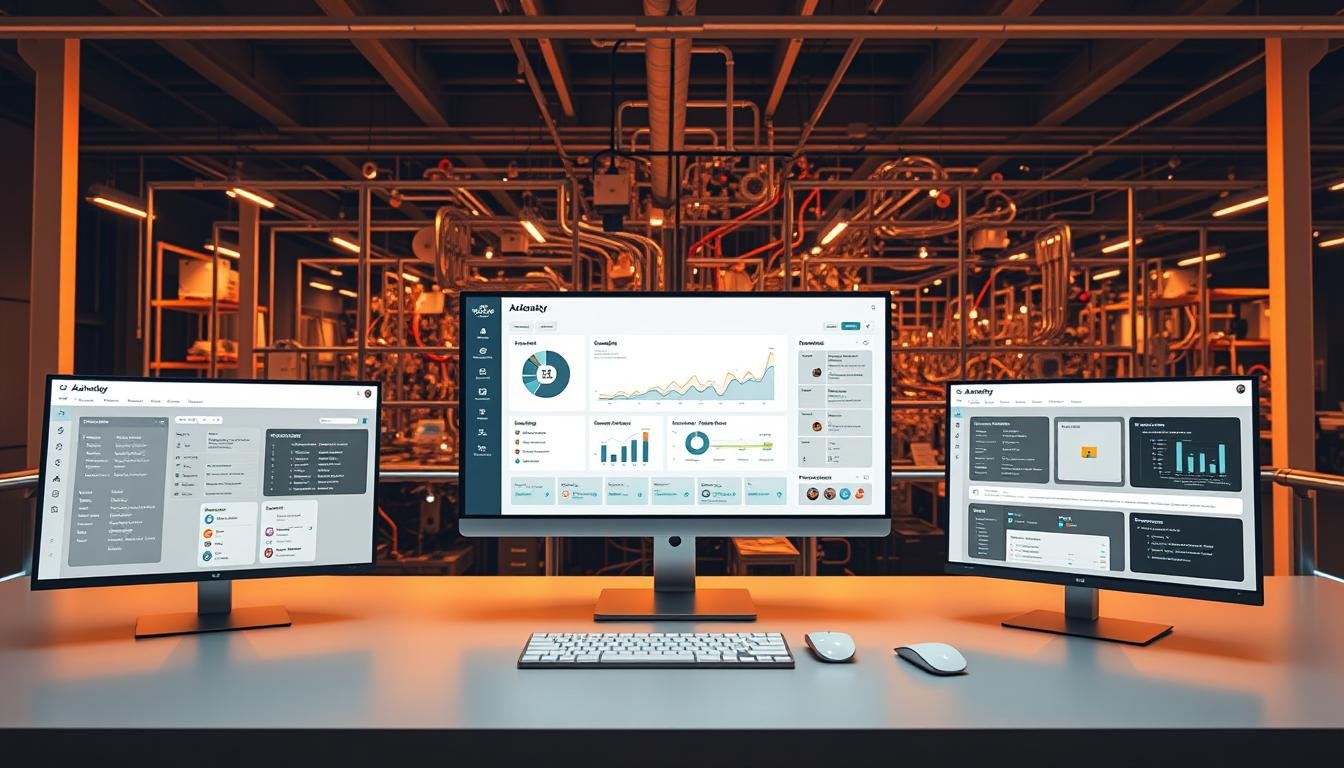Did you know that programming is no longer just for “techy” children? In today’s world, it’s a skill that fosters creativity, problem-solving, and critical thinking. Whether your child is building a game or solving puzzles, programming offers endless opportunities to learn and grow.
According to a 2025 survey, 75% of professionals believe programming is essential in the age of AI. This guide is designed to help parents and educators introduce young learners to programming through simple, engaging projects. From screen-free activities to beginner-friendly platforms, we’ve got you covered.
Ready to explore the world of computer science with your child? Let’s dive into practical ideas and resources that make learning fun and accessible.
Key Takeaways
- Programming is a creative process that teaches problem-solving and critical thinking.
- 75% of professionals consider it a vital skill in the AI era.
- This guide offers practical projects and platform recommendations.
- Screen-free activities like CS Unplugged are great for beginners.
- Programming is now a universal skill, not just for “techy” children.
Introduction to Coding for Kids
Programming is like learning a new language that helps children communicate with computers. It’s not just about typing lines of text; it’s about solving problems and creating something meaningful. Whether it’s through block-based tools like ScratchJr or text-based languages like Python, kids learn code in ways that match their age and skill level.
For younger children, tools like Coding Safari (ages 2+) introduce pre-coding skills through fun activities. Older kids can explore Swift Playgrounds (ages 8-12), which teaches Apple’s Swift language in an interactive way. These platforms make learning code engaging and accessible.
MIT’s Scratch platform, with over 8 million global users, is another excellent resource. It allows children to create interactive stories, games, and animations. This hands-on approach not only teaches programming but also boosts creativity and problem-solving skills.
Parents play a crucial role in this journey. Balancing screen time with unplugged activities ensures a healthy learning environment. By introducing programming early, you’re helping your child develop skills that will benefit them in the future.
Why Coding is Important for Kids
In today’s tech-driven world, mastering programming is becoming a necessity, not just an option. With 90% of U.S. parents advocating for its inclusion in school curricula, it’s clear that programming is seen as a vital skill for the future. It’s not just about writing lines of code—it’s about equipping children with the tools to thrive in a digital age.
Programming fosters computational thinking, a skill that involves breaking complex problems into smaller, manageable steps. This approach, known as decomposition, teaches children how to tackle challenges methodically. Whether they’re building a game or debugging an error, they’re learning to think critically and logically.
Unlike passive tech consumption, programming encourages active creation. Platforms like CodeCombat have successfully taught JavaScript through gameplay, turning learning into an engaging experience. By building their own projects, children move from being consumers to creators, which boosts their confidence and creativity.
Another key benefit is resilience. Debugging code teaches perseverance and problem-solving. Every error is an opportunity to learn, fostering a growth mindset that extends beyond programming. These skills are essential for future careers in AI, robotics, and web development.
As AI continues to evolve, even AI-generated code requires human oversight. This underscores the importance of programming as a foundational skill. By introducing children to programming early, we’re preparing them for a future where these languages will be indispensable.
Top Coding Platforms for Kids in 2025
Exploring programming platforms can open doors to creativity and innovation for young learners. With so many options available, finding the right platform is key to making learning both fun and effective. Whether your child is a beginner or ready for advanced challenges, these tools offer something for everyone.
CodaKid
CodaKid is an award-winning platform that offers self-paced courses in languages like Python and Roblox Lua. Designed for ages 6-18, it includes AI tracks and live mentor support. This makes it a great choice for kids who want to dive deeper into programming.
Code Monkey
Code Monkey uses gamified challenges, such as “Catch Bananas,” to teach kids CoffeeScript and Python. With over 100 million levels solved, it aligns with CSTA standards and keeps learning engaging. It’s perfect for children who enjoy solving puzzles and playing games.
Scratch
MIT’s Scratch is a free, block-based platform that lets kids create animations, stories, and games. With support for 45+ languages, it’s ideal for beginners. Its user-friendly interface encourages creativity and collaboration, making it a favorite among educators and parents.
When comparing options, consider pricing and focus. CodeMonkey’s home plan is affordable, while Tynker caters more to schools. For free resources, Code.org offers tutorials themed around Minecraft and Star Wars. These courses make learning accessible and exciting for all ages.
Simple Coding Projects for Kids
Simple projects are a great way to introduce children to the world of programming. These activities not only teach the basics but also make learning fun and engaging. From creating games to building websites, there’s something for every young learner.
Creating a Simple Game with Scratch
Scratch is a fantastic tool for beginners. Kids can create interactive games by using event triggers like “when sprite clicked” and loops. This hands-on approach helps them understand programming concepts while having fun. Scratch’s block-based interface makes it easy for young learners to experiment and create.
Building a Website with HTML
Introduce kids to web development by teaching them HTML basics. Start with simple tags like
and
using CodePen’s live editor. Once they’re comfortable, they can host their website on GitHub Pages. This project combines creativity with technical skills, giving kids a sense of accomplishment.
Programming a Robot with LEGO Boost
LEGO Boost is perfect for kids aged 7-12. Using drag-and-drop code, they can program motor movements and sounds for over five models. This project teaches problem-solving and logical thinking while keeping kids engaged. LEGO’s app makes it easy to get started and explore endless possibilities.
For parents, it’s important to ensure a safe learning environment. Use parental controls on platforms like Roblox Studio and choose beginner-friendly IDEs like Thonny for Python or BlueJ for Java. These tools provide a secure and supportive space for young learners to explore programming.
By starting with these simple projects, kids can build confidence and develop essential skills. Whether they’re creating games, building websites, or programming robots, these activities lay the foundation for future learning and creativity.
Benefits of Learning Coding at a Young Age
Starting programming early can unlock a world of opportunities for young minds. Research shows that platforms like Kodable (ages 6+) improve math scores by 16%, while Vidcode’s AR projects boost STEM interest. These activities not only teach technical skills but also foster creativity and logic.
Programming enhances executive functioning. For example, planning game levels in Unity sharpens organizational skills. It also fosters collaboration, as seen in CoderDojo’s hackathons, where kids work with mentors to solve challenges. These experiences build confidence, with 7-year-olds publishing Scratch games to moderated communities.
Early programming prepares children for advanced learning. CodeHS’s JavaScript and Python pathways help students get ready for AP Computer Science. A longitudinal study found that early coders excel in algebra and geometry, showcasing the long-term benefits of this development.
By introducing programming early, children develop computational thinking—a skill that involves breaking complex problems into smaller steps. This approach not only helps in programming but also in everyday problem-solving. The combination of creativity, logic, and technical skills makes programming a valuable tool for future success.
How to Choose the Right Coding Platform for Your Child
Choosing the right platform for your child’s programming journey can make all the difference. With so many options available, it’s important to find one that matches their interests and skill level. For example, Roblox Studio is perfect for gamers, while Vidcode appeals to young video creators.
When evaluating a coding platform, consider the support it offers. CodeMonkey provides teacher dashboards for structured learning, while Pluralsight relies on community forums for peer assistance. Both approaches have their merits, depending on your child’s learning style.
Device compatibility is another key factor. Swift Playgrounds works exclusively on iOS, whereas Scratch is accessible across multiple devices. Ensure the platform you choose aligns with the tools your child already uses.
Many platforms offer trial periods, which can help you make an informed decision. CodeSpark provides 7-day free access, and CodaKid offers a 14-day refund policy. These trials allow you to test the curriculum and see if it’s a good fit.
Finally, prioritize safety. Platforms designed for children under 13 should comply with COPPA regulations. This ensures a secure learning environment for your child. By considering these factors, you can select a platform that enhances their experience and fosters their growth.
Resources for Parents to Support Their Child’s Coding Journey
Parents play a vital role in nurturing their child’s interest in programming by providing the right tools and guidance. With so many resources available, it’s easier than ever to help your child explore this exciting field. From free online tools to local workshops, there’s something for every family.
Start with free platforms like Algorithm City for Android or Grasshopper for JavaScript. These tools make learning interactive and fun. Google’s CS First also offers lesson plans and activities designed for young learners. These resources are perfect for beginners.
For structured learning, consider courses like Udemy’s parent-child Python classes, priced at $12.99. GitHub’s student pack provides access to premium tools, while Code.org’s unplugged activities teach programming concepts without a computer. These options cater to different learning styles and budgets.
Local libraries often host CoderDojo chapters or Raspberry Pi workshops. These events provide hands-on experience and foster a sense of community. Books like “Hello Ruby” for ages 4-8 and “Python for Kids” by Jason Briggs are also excellent resources for at-home learning.
To track your child’s progress, use Khan Academy’s skill metrics or review their portfolio regularly. Joining communities like STEM Facebook groups or Stack Overflow for teens can also provide additional support and inspiration. These steps ensure your child’s development is on the right track.
Conclusion
Programming is a gateway to creativity and problem-solving for young minds. It’s not just about preparing for a career—it’s about building foundational skills that shape the future. Starting small, like with Hour of Code or free challenges, can spark a lifelong interest in learning.
The long-term benefits are immense. From AP exam readiness to hackathon scholarships, programming opens doors to countless opportunities. Encourage your child to explore free classes or summer camps to dive deeper into this exciting field.
By embracing programming, children transform from tech consumers to innovators. Start their journey today and watch them create, solve, and thrive.
FAQ
What is the best age for kids to start learning programming?
Children as young as 5 or 6 can begin exploring basic concepts through visual tools like Scratch. Older kids, around 8-12, can dive into more complex languages like Python or JavaScript.
How can I make programming fun for my child?
Use interactive platforms like Code Monkey or LEGO Boost to turn learning into a game. Projects like building a website or creating a simple game also keep kids engaged.
What are the benefits of teaching kids programming early?
Early exposure helps develop computational thinking, problem-solving skills, and creativity. It also prepares them for future careers in technology and other fields.
Which programming language should my child start with?
Beginners often start with block-based languages like Scratch. As they progress, they can move to text-based languages like Python, which is beginner-friendly and widely used.
Are there free resources for kids to learn programming?
Yes, platforms like Scratch and Code.org offer free tools and lesson plans. Many websites also provide tutorials and challenges tailored for young learners.
How can I support my child’s programming journey?
Encourage exploration, provide access to learning tools, and celebrate their achievements. You can also enroll them in online courses or coding camps for structured learning.
What are some simple projects for kids to start with?
Beginners can create animations with Scratch, build a basic website using HTML, or program a robot with LEGO Boost. These projects make learning hands-on and enjoyable.
How do I choose the right platform for my child?
Consider their age, interests, and skill level. Platforms like CodaKid and Code Monkey offer tailored curricula, while Scratch is ideal for younger kids.









